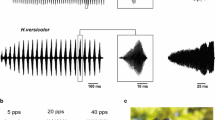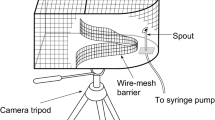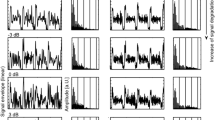Summary
An experimental paradigm is introduced to determine minimal interaural intensity and time differences used as cues for the lateralization behaviour of the male grasshopper,Chorthippus biguttulus. By presenting synthetic female sound via two miniature, bilaterally arranged speakers a quasi-dichotic stimulus situation could be achieved under predictable error estimations (Fig. 1).
-
(1)
The resolution of the grasshopper's auditory system for interaural intensity differences is about 1–2 dB (Figs. 3, 4). At intensity differences above 1.6 dB turns towards the ‘leading side’ are performed without any error, the 75% (resp. 25%) threshold of correct choice is achieved at 0.6 dB. The response characteristics also document the high degree of conformity between the animals and the degree of individual auditory handedness which was found to be maximally 1 dB.
-
(2)
The resolution for interaural time differences (at equal sound intensities on both sides) is of the order of 1.0 ms (Fig. 5). The 75% (resp. 25%) threshold of correct choice is achieved at 0.4 ms.
Similar content being viewed by others
References
Blauert J (1974) Räumliches Hören. Hirzel, Stuttgart, pp 113–142
Boyan GS (1979) Directional responses to sound in the central nervous system of the cricketTeleogryllus commodus (Orthoptera Gryllidae). I. Ascending interneurons. J Comp Physiol 130:137–150
Boyan GS (1984) Neural mechanisms of auditory information processing by identified interneurones in Orthoptera. J Insect Physiol 30:27–41
Dörrscheidt GJ, Rheinlaender J (1980) Computer generation of sound models for behavioural and neurophysiological experiments in insects. J Insect Physiol 26:717–727
Gray EG (1960) The fine structure of the insect ear. Phil Trans R Soc Lond B 243:75–94
Heller KG, Heiversen D von (1986) Acoustic communication in phaneropterid bushcrickets: species-specific delays of female stridulatory response and matching male sensory time window. Behav Ecol Sociobiol 18:189–198
Helversen D von (1972) Gesang des Männchens und Lautschema des Weibchens bei der FeldheuschreckeChorthippus biguttulus (Orthoptera, Acrididae). J Comp Physiol 81:381–422
Helversen D von (1984) Parallel processing in auditory pattern recognition and directional analysis by the grasshopperChorthippus biguttulus L. (Acrididae). J Comp Physiol A 154:837–846
Helversen D von, Heiversen O von (1983) Species recognition and acoustic localization in acridid grasshoppers: a behavioural approach. In: Huber F, Markl H (eds) Neuroethology and behavioral physiology. Springer, Berlin Heidelberg New York, pp 95–107
Hill KG, Boyan GS (1977) Sensitivity to frequency and direction of sound in the auditory system of crickets (Gryllidae). J Comp Physiol 121:79–97
Houben D, Gourevitch G (1979) Auditory lateralization in monkeys: an examination of two cues serving directional hearing. J Acoust Soc Am 66:1057–1063
Jeffress LA (1975) Localization of sound. In: Keidel WD, Neff WD (eds) Auditory system (Handbook of sensory physiology, Vol V/2). Springer, Berlin Heidelberg New York, pp 449–459
Kleindienst HU, Koch UT, Wohlers DW (1981) Analysis of the cricket auditory system by acoustic stimulation using a closed sound field. J Comp Physiol 141:283–296
Konishi M (1983) Neuroethology of acoustic prey localization in the barn owl. In: Huber F, Markl H (eds) Neuroethology and behavioral physiology. Springer, Berlin Heidelberg New York, pp 303–317
Latimer W, Lewis DB (1986) Song harmonic content as a parameter determining acoustic orientation behaviour in the cricketTeleogryllus oceaniens (Le Guillou). J Comp Physiol A 158:583–591
Lewis DB (1983) Directional cues for auditory localization. In: Lewis B (ed) Bioacoustics. A comparative approach. Academic Press, London, pp 233–257
Michelsen A (1979) Insect ears as mechanical systems. Am Sci 67:696–706
Michelsen A, Larsen ON (1984) Hearing and sound. In: Kerkut GA, Gilbert LI (eds) Comprehensive insect physiology, biochemistry and pharmacology. Pergamon Press, Oxford New York Toronto Sydney Paris Frankfurt, pp 495–556
Michelsen A, Nocke H (1974) Biophysical aspects of sound communication in insects. Adv Insect Physiol 10:247–296
Miller LA (1977) Directional hearing in the locustSchistocerca gregaria (Acrididae, Orthoptera). J Comp Physiol 119:85–98
Mills AW (1958) On the minimum audible angle. J Acoust Soc Am 30:237–241
Mills AW (1972) Auditory localization. In: Tobias JV (ed) Foundations of modern auditory theory. Academic Press, New York, pp 303–348
Mörchen A, Rheinlaender J, Schwartzkopff J (1978) Latency shift in insect auditory nerve fibres: a neuronal time cue for sound direction. Naturwissenschaften 65:656–657
Murphey RK, Zaretsky MD (1972) Orientation to calling song by female cricketsScapsipedus marginatus (Gryllidae). J Exp Biol 56:335–352
Oldfield BP (1980) Accuracy of orientation in female crickets,Teleogryllus oceanicus (Gryllidae): dependence on song spectrum. J Comp Physiol 141:93–99
Rheinlaender J (1984) Das akustische Orientierungsverhalten von Heuschrecken, Grillen und Fröschen: Eine vergleichende neuro- und verhaltensphysiologische Untersuchung. Habilitationsschrift, Fakultät für Biologie, Ruhr-Universität Bochum
Rheinlaender J, Blätgen G (1982) The precision of auditory lateralization in the cricket,Gryllus bimaculatus. Physiol Entomol 7:209–218
Rheinlaender J, Mörchen A (1979) ‘Time-intensity trading’ in locust auditory interneurons. Nature 281:672–674
Rheinlaender J, Römer H (1980) Bilateral coding of sound direction in the CNS of the bushcricketTettigonia viridissima L. (Orthoptera, Tettigoniidae). J Comp Physiol 140:101–111
Robinson D, Rheinlaender J, Hartley JC (1986) Temporal parameters of male-female sound communication inLeptophyes punctatissima. Physiol Entomol 11:317–323
Römer H (1976) Die Informationsverarbeitung tympanaler Rezeptorelemente vonLocusta migratoria (Acrididae, Orthoptera). J Comp Physiol 109:101–122
Römer H, Rheinlaender J (1983) Electrical stimulation of the tympanal nerve as a tool for analysing the responses of auditory interneurons in the locust. J Comp Physiol 152:289–296
Schmitz B, Scharstein H, Wendler G (1982) Phonotaxis inGryllus campestris L. (Orthoptera, Gryllidae). I. Mechanisms of acoustic orientation in intact female crickets. J Comp Physiol 148:431–444
Shuvalov VF, Popov AV (1979) Dependence of spectral selectivity of phonotaxis in cricketsGryllus bimaculatus from the kind of presentation of sound stimuli. Acad Sci USSR 246:247–249 (in Russian)
Thorson J, Weber T, Huber F (1982) Auditory behavior of the cricket. II. Simplicity of calling-song recognition inGryllus, and anomalous phonotaxis at abnormal carrier frequencies. J Comp Physiol 146:361–378
Wakeford OS, Robinson DE (1974) Lateralization of tonal stimuli by the cat. J Acoust Soc Am 55:649–652
Weber T, Thorson J, Huber F (1981) Auditory behavior of the cricket. I. Dynamics of compensated walking and discrimination paradigms on the Kramer treadmill. J Comp Physiol 141:215–232
Wegener JG (1974) Interaural intensity and phase angle discrimination by rhesus monkeys. J Speech Hear Res 17:638–655
Wolf H (1986) Response patterns of two auditory interneurons in a freely moving grasshopper (Chorthippus biguttulus L.). J Comp Physiol A 158:697–703
Zhantiev RD, Korsunovskaya OS (1986) Sound communication in bushcrickets (Tettigoniidae, Phaneropterinae) of the European part of the USSR. Zool J 65:1151–1163 (in Russian)
Author information
Authors and Affiliations
Additional information
Dedicated to Prof. Dr. Drs. h.c. Hansjochem Autrum on the occasion of his 80th birthday
Rights and permissions
About this article
Cite this article
von Helversen, D., Rheinlaender, J. Interaural intensity and time discrimination in an unrestraint grasshopper: a tentative behavioural approach. J. Comp. Physiol. 162, 333–340 (1988). https://doi.org/10.1007/BF00606121
Accepted:
Issue Date:
DOI: https://doi.org/10.1007/BF00606121




